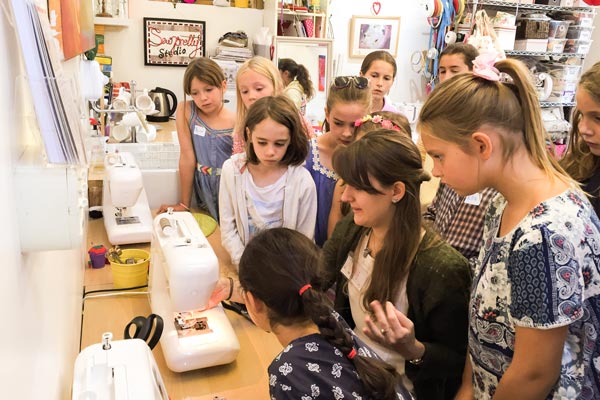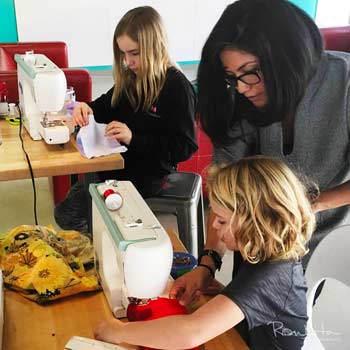Sewing Lessons for Kids: A Perfect Activity for Creative Development
Sewing Lessons for Kids: A Perfect Activity for Creative Development
Blog Article
Unlock New Skills: Why You Ought To Think About an Embroidery Lesson for Kids
In a world dominated by electronic disturbances, stitching lessons for kids arise as an unexpected yet engaging opportunity for skill-building. These lessons, which cultivate imagination, great electric motor abilities, and analytical, offer greater than just a charming pastime. They cultivate resilience, impart persistence, and introduce fundamental life abilities. As youngsters yield tangible arise from their difficult work, a sense of achievement occurs, causing an extensive change in their self-confidence. Discover why these lessons could be a transformative experience for your child.
The Art of Stitching: An Introduction
Stitching, a timeless art, encompasses an array of techniques that have actually been given with generations. When early people made use of bones and pet sinews to join pieces of hair and hide, its origins date back to the Paleolithic period. With time, this rudimentary technique progressed into an innovative craft, incorporating utility and visual appeals.
From hand-sewing to maker stitching, the treatments differ across societies and contexts. Some develop complex needlework, others fashion tough garments, while certain techniques serve ritualistic purposes. Standard quilting in The United States and copyright, Sashiko in Japan, or Kantha in India exemplify the variety of this craft.
Today, in spite of technical improvements, the relevance of stitching dominates. Presenting children to sewing can be a useful financial investment, cultivating creativity, enhancing hand-eye sychronisation, and passing on a sense of success.
Secret Benefits of Sewing Instructions for Kids
Sewing promotes youngsters's capability to bring ideas to life, thus fostering their creative and creative side. When a stitch goes incorrect or a pattern needs adjustment, children must design remedies, consequently refining their critical reasoning.
Embroidery lessons likewise imbue persistence and perseverance. Embroidery is a thorough craft, calling for sufficient time and precision. This can instruct children the worth of persistence, and the value of persisting with a job to achieve an adequate result. Moreover, it boosts hand-eye sychronisation. The act of threading a needle or complying with a pattern improves fine electric motor skills.
Last but not least, stitching can be a confidence booster - sewing lessons for kids. Every finished job brings a feeling of achievement, enhancing kids's self-esteem. Stitching lessons can bring a host of benefits, making it an important enhancement to youngsters' skill-building activities.
Exactly How Sewing Improves Youngster Development
With a myriad of cognitive and practical advantages, the impact of stitching on children's advancement is extensive. This hands-on activity motivates the development of fine electric motor abilities as youngsters navigate via the fabric with a needle, cultivating precision and mastery. The focus required for stitching likewise boosts focus and attention period, essential high qualities for scholastic success.
Beyond physical abilities, stitching aids cognitive development. It includes understanding directions, planning, and analytic - every one of which boost the brain's executive features. Furthermore, it introduces children to fundamental mathematical ideas like forms, dimensions, and portions in a useful, interesting fashion.
Finally, embroidery has emotional advantages. The procedure of creating something tangible boosts a child's self-esteem and sense of achievement. The persistence and willpower required to finish an embroidery task additionally educate valuable life lessons concerning difficult work and the weblink happiness of seeing a task with to completion.
Age-Appropriate Sewing Projects for Kids
Having understood the myriad benefits of sewing for child development, it is equally important to take into consideration ideal sewing tasks that align with a child's age and ability level. For young novices, ages 5-7, basic tasks like threading beads onto a string can improve hand-eye coordination. As they get older, ages 8-10, they can proceed to stitching buttons or crafting small fabric things such as pillow cases.

Selecting the Right Stitching Lesson for Your Kid
Exactly how does one go regarding choosing the ideal stitching lesson for their kid? It starts with understanding the child's interest degree and capability. If the youngster is a total novice, a basic sewing course covering basic stitches and precaution would certainly be suitable. For those with a little experience, a program that introduces patterns or even more complicated projects could be better.
Does the child discover far better in a group setting or individually? A well-informed and patient teacher can make all the difference in a kid's learning experience.

Conclusion
In final thought, stitching lessons offer an enhancing experience that expands beyond creative thinking. They promote crucial life skills like analytical, perseverance, and mathematical concepts. Age-appropriate sewing projects not only improve self-confidence but likewise sustain overall child advancement. Consequently, considering a sewing lesson for your child can undoubtedly open a myriad of brand-new skills and give an unique, important discovering chance.
Having understood the myriad advantages of stitching for kid advancement, it is equally vital to take into consideration ideal sewing jobs that line up with a child's age and ability degree. sewing lessons for kids.Exactly how does one go about choosing the try this site appropriate sewing lesson for their child? If the youngster discovers better in a physical setting, regional sewing lessons might be a good alternative. In final thought, these factors play a substantial role in choosing the appropriate stitching lesson for a child
Age-appropriate sewing tasks not just boost self-confidence however you can try this out also sustain total kid development.
Report this page